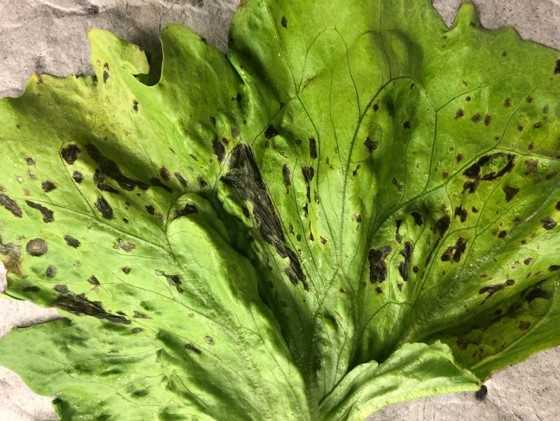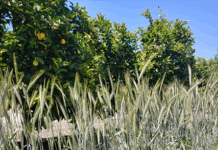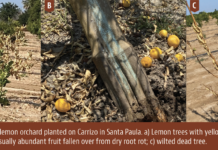
Bacterial Leaf Spot (BLS) of lettuce was first reported in the U.S. in 1918 in South Carolina. The disease then expanded to other production areas in California, Arizona and ultimately in Florida. The disease causes losses of entire production when outbreaks are significant. This disease is particularly devastating to the leafy vegetable industry because it is favored by warm and humid conditions. Besides the U.S., the disease has been reported in lettuce production in Europe, Asia and South America as well.
BLS is caused by the bacterium Xanthomonas hortorum patovar. vitians, formerly described as X. campestris pv. vitians (the pathovar (pv) vitians is unique to lettuce.) The bacterium can attack any type of cultivated lettuce; no relationship between lettuce type and immunity to the pathogen is known. The bacterium has three races identified thus far: races 1, 2 and 3, but race 1 has been reported in western and eastern lettuce production areas in the U.S. BLS is sporadic in lettuce with losses up to 100% in subtropical productions areas. Xanthomonas hortorum pv. vitians reproduces quickly when high humidity, leaf wetness and high temperatures are conducive for disease development. The infection starts as small brown spots that in later stages of disease development coalesce to form bigger spots.
Here in Florida at least one small outbreak is reported by growers during the growing season from October to May. Lettuce growers in Florida are the most affected by this disease because the warmer and more humid conditions in the state are more conducive for disease development; after a severe infection occurs, lettuce cannot be commercialized.
In the last five years, growers have been able to contain the disease from spreading to other lettuce farms nearby by destroying infested crop areas with lettuce BLS; therefore, small losses were manageable, and growers did not lose entire crops.
Control Methods
The disease is not prophylactically controlled as other lettuce diseases such as downy mildew, sclerotinia drop and powdery mildew because it is uncertain when the pathogen population will increase and develop to cause diseases. There are no bactericides that can eradicate BLS from lettuce production. Copper-based compounds can be effective in reducing the severity and incidence of outbreaks of BLS when the disease first appears. However, there is a potential for development of resistance to copper in the pathogen population following repeated applications.
The high variability of disease outbreaks each year makes it impossible to predict when preventative applications of copper should be used. A combination of a copper fungicide with mancozeb may be effective to reduce BLS in lettuce; both compounds have some efficacy against bacteria but are protectants and not curative. Systemic Acquired Resistance based fungicides probably have limited activity but can be used as preventative as well.
Several practices may help reduce outbreaks of lettuce BLS. These practices, however, should be part of an integrated disease management program instead of recommended alone.
Crop destruction at the point of infection and surrounding areas have proved to be effective to avoid other neighboring lettuce fields from becoming infected. This strategy has been successful in containing disease spread to other fields during recent small outbreaks in Florida. However, when the disease is highly spread, this strategy may not be economically feasible. This recommendation may only help in early detection of the disease.
The bacterium is believed to be transmitted in infested seed, which is the most common avenue of disease introduction. The use of disease-free seed is highly recommended, but to date there is no effective method to detect the pathogen on seeds and assure cleanliness from BLS. Seed production should be conducted in dry, cool environments with less likelihood of bacterium development.
The BLS pathogen spreads by rain and overheard irrigation. Drip irrigation can be used to mitigate spread of the disease by keeping foliage as dry as possible. In California and Arizona, most lettuce fields are drip irrigated. However, drip irrigation is not economically feasible in Florida’s commercial field production currently.
An adequate weed control in nearby areas of lettuce fields is highly recommended because the pathogen may be epiphytic on weeds. Many weed species such as those in the families Asteraceae, Amaranthaceae, Aizoaceae, Chenopodiaceae, Portulacaceae, Solanaceae and Malvaceae may host the pathogen, X. hortorum pv. vitians.
Ultimately, host resistance is the most efficient control method against the BLS disease. BLS resistance can be found in certain heirloom lettuce cultivars that are not acceptable for commercial production. Disease resistance towards race 1 strains of the pathogen can be easily transferred to romaine, iceberg and leaf lettuce cultivars using traditional breeding methods. There have been releases from the USDA Agricultural Research Service of lettuce lines with resistance to race 1 for the California/Arizona lettuce production system. The University of Florida is developing such resistances for the Florida production system. Resistance to races 2 and 3 against X. campestris pv, vitians remains to be reported.
Further Research
A partnership was formed between plant breeders, geneticists, plant pathologists, weed management scientists and extension agents from the University of Florida Institute for Food and Agricultural Sciences, Pennsylvania State University and USDA-ARS. This partnership will investigate the lettuce BLS interactions using several approaches that include breeding, lettuce genetics, pathogen genetics and detection. Researchers will improve lettuce cultivars against several races of X. hortorum pv. vitians and provide information on pathogen and lettuce genetics that will help the industry to efficiently manage this detrimental disease; this information will be released to growers, producers, the seed industry and other stakeholders in English and Spanish.




















